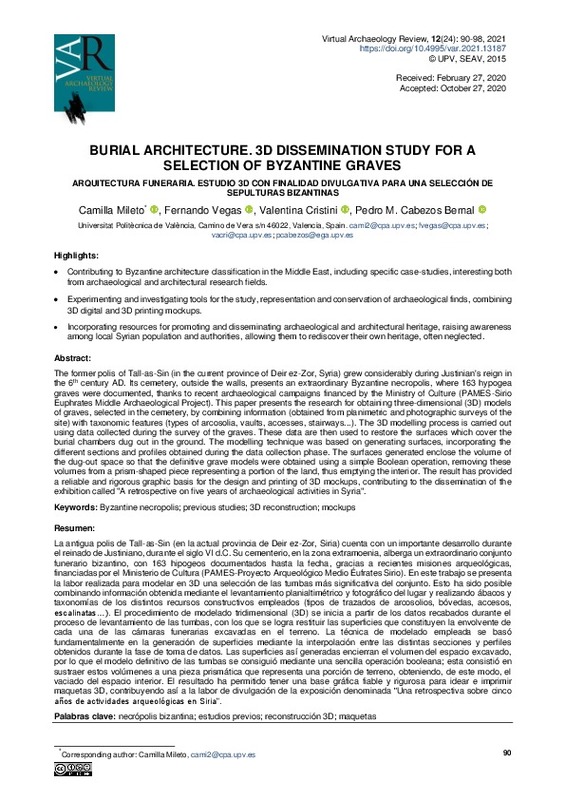Banfi, F., Brumana, R., & Stanga, C. (2019). Extended reality and informative models for the architectural heritage: from scan-to-BIM process to virtual and augmented reality. Virtual Archaeology Review, 10(21), 14-30. https://doi.org/10.4995/var.2019.11923
Bessac, J. C. (2005). Techniques de marquage e de gravure sur Pierre. Actes du Colloque International de Glypthographie, (pp. 57-73). Brain Le Château: Sifée.
Bessac, J. C. (1999). L'arquéologie de la pierre de taille. La construction: la pierre, (4), 9-52.
[+]
Banfi, F., Brumana, R., & Stanga, C. (2019). Extended reality and informative models for the architectural heritage: from scan-to-BIM process to virtual and augmented reality. Virtual Archaeology Review, 10(21), 14-30. https://doi.org/10.4995/var.2019.11923
Bessac, J. C. (2005). Techniques de marquage e de gravure sur Pierre. Actes du Colloque International de Glypthographie, (pp. 57-73). Brain Le Château: Sifée.
Bessac, J. C. (1999). L'arquéologie de la pierre de taille. La construction: la pierre, (4), 9-52.
Blétry-Forestier, S. (2015). Zénobia-Halabiya, habitat urbain et nécropoles: cinq années de recherches de la mission syro-française (2006-2010) (pp. 572-). Sociedad Luso-Gallega de Estudios Mesopotamicos.
Boochs, F., Trémeau, A., Murphy, O., Gerke, M., Lerma, J. L., Karmacharya, A., & Karaszewski, M. (2014). Towards a knowledge model bridging technologies and applications in cultural heritage documentation. Annals of the Photogrammetry, Remote Sensing and Spatial Information Sciences, II(5), 81-88. https://doi.org/10.5194/isprsannals-II-5-81-2014
Calvo Hernando, M. (2001). Divulgación y periodismo científico, entre la claridad y la exactitud. Ciudad de México: Universidad Autónomica de México.
Dentzer, J. M., & Orthmann, W. (1989). Archéologie et Histoire de la Syrie. Saarbüken: Erps.
Fenollós J. L., & Al-Shbib, S. (2008). La necrópolis bizantina de Tall-es-Sin (Deir ez-Zor, Siria). Memorias del Proyecto Arqueológico Medio Éufrates Sirio-I, Madrid: CSIC.
Henson, D. (2004). Archaeology and education, an exercise in constructing the past. Treballs d'Arqueologia, 10, 5-12.
Hupperetz, W., Carlani, R., Pletinckx, D., & Pietroni, E. (2012). Etruscanning 3D project. The 3D reconstruction of the Regolini Galassi Tomb as a research tool and a new approach in storytelling. Virtual Archaeology Review, 3(7) ,92-96. https://doi.org/10.4995/var.2012.4395
Iturbe, A., Cachero, R., Cañal, D., & Martos, A. (2018). Virtual digitization of caves with parietal Paleolithic art from Bizkaia. Scientific analysis and dissemination through new visualization techniques. Virtual Archaeology Review, 9(18), 57-65. https://doi.org/10.4995/var.2018.7579
Knoll, W., & Hechinger, M. (2001). Maquetas de arquitectura, técnica y construcción. Ciudad de México: Gustavo Gili.
Krautheimer, R. (1989). Early Christian and byzantine architecture, London: Pinguin.
Kuzminsky, S. C., & Gardiner, M. S. (2012). Three-dimensional laser scanning:potential uses for museum conservation and scientific research. Journal of Archaeological Science, 39(8), 2744-2751. https://doi.org/10.1016/j.jas.2012.04.020
Lauffray, J. (1983). Halabiyya-Zenobia, place forte du limes oriental et la haute Mésopotamie au VI siècle. Les duchs frontaliers de Mesopotamie et les fortifications de Zenobia (Vol. 1). Paris: Geuthner.
Lauffray, J. (1991). Halabiyya-Zenobia, place forte du limes oriental et la haute Mésopotamie au VI siècle. L'architecture publique, prive et funerarie (Vol. 2). Paris: Geuthner.
Lentini, D. (2009). The funeral area in "Ponte Della Lama Canosa" (III-VI century). An hypothesis of 3D historicalmonumental reconstruction. International Archives of Photogrammetry, Remote Sensing and Spatial Information Science, XXXVIII-5/W1. https://www.isprs.org/proceedings/XXXVIII/5-W1/pdf/lentini.pdf
Lerma, J. L., & Muir, C. (2014). Evaluating the 3D documentation of an early Christian upright stone with carvings from Scotland with multiples images. Journal of Archaeological Science, 46, 311-318. https://doi.org/10.1016/j.jas.2014.02.026
Mango, C. (1985). Byzantine Architecture (pp. 54-123). Milan: Electa.
Manzano, S. (2019). Arquitectura funeraria en el conjunto arqueológico Tell Keila: levantamiento, caracterización, y estado de conservación, Final Master Thesis, Universitat Politécnica de Valéncia, unpublished. http://hdl.handle.net/10251/126334
Manzano, S., Vegas, F., Cristini, V., & Hueto, A. (2020). A burial grave at Tell Keila, Palestine. International Archives of the Photogrammetry, Remote Sensing and Spatial Information Sciences, XLIV. https://doi.org/10.5194/isprs-archives-XLIV-M-1-2020-999-2020
Mileto, C., Vegas, F., Guimaraens, G., & Diodato, M. (2008). The preliminary study of the western Basilica of Zenobia-Halabieh city. Arché, 3, 249-256. https://riunet.upv.es/handle/10251/31840
Mileto, C., Vegas, F., Cristini, V. & García Sáez, S. (2018). Al hilo entre la arquitectura y la arqueología: estudio y caracterización de construcciones bizantinas en Siria. Restauro Archeologico, 27(1), 44-65. http://doi.org/10.13128/RA-23460
Montero, J. L., & Al-Shbib, S. (Eds.) (2008). La necrópolis bizantina de Tall As-Sin (Deir Ez-Zor, Siria). Madrid: CSIC.
Ponchio, F., Callieri M., Dellepiane, M., & Scopigno, R. (2020). Effective Annotations over 3D Models. Computer Graphics Forum, 39(1), 89-105. https://doi.org/10.1111/cgf.13664
Reda Sbeinati, M., Darawcheh, R., & Mouty, M. (2005). The historical earthquakes of Syria: an analysis of large and moderate earthquakes from 1365 B.C. to 1900 A.D. Annals of Geophysics, 48(3), 347-435.
Rossi, A., & Cabezos, P. M. (2018). Il valore paradigmatico del Grande Plastico di Pompei. Disegnare Idee Immagini, 48(3), 62-71.
Sarte, M. (2001). D'alexandre a Zenobie, Histoire du Levant Antique, Paris: Points.
Stampouloglou, M. Toska, O., Tapinaki, S., Kontogianni, G., Skamantzari, M., & Georgopoulos, A. (2020). Archaeological anastylosis of two Macedonian tombs in a 3D virtual environment. Virtual Archaeology Review, 11(22), 26-40. https://doi.org/10.4995/var.2020.11877
Statham, N. (2019). Scientific rigour of online platforms for 3D visualization of heritage. Virtual Archaeology Review, 10(20), 1-16. https://doi.org/10.4995/var.2019.9715
Talaverano, R. (2014). Documentación gráfica de edificios históricos: principios, aplicaciones y perspectivas. Arqueología de la Arquitectura, 11, 1-26. http://dx.doi.org/10.3989/arq.arqt.2014.014
Tryfona, M. S., & Georgopoulos, A. (2016). 3D image based geometric documentation of the Tower of Winds. International Archives of Photogrammetry, Remote Sensing and Spatial Information Science, XLI-B5, 969-975. https://doi.org/10.5194/isprs-archives-XLI-B5-969-2016
Valle Melón, J. M., Lopetegi Galarraga, A., & Rodriguez Miranda, A. (2005). Problems when generating virtual models representing real objects: Hondarribia walls. In R. Vergnieux & C. Delevoie (Eds.), Virtual Retrospect 2005. Ausonius.
Vegas, F., Mileto, C., & Cristini, V. (2007). Hypogeum Tombs in the Byzantine Necropolis at Tall-es Sinn, Syria. Arché, 2, 159-166. https://riunet.upv.es/handle/10251/32261
Vegas, F., Mileto, C., García Soriano, L., & García Sáez, S. (2011). Estudio previo de la ciudad y la necrópolis de Zenobia-Halabiyeh (Siria). Arché, (6-7), 471-480. https://riunet.upv.es/handle/10251/34640
[-]









